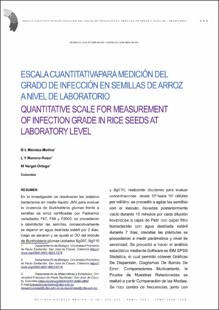QUANTITATIVE SCALE FOR MEASUREMENT OF INFECTION GRADE IN RICE SEEDS AT LABORATORY LEVEL
Artículo de revista
2021-04-26
Revista Boletin Redipe
En la investigación se reactivaron los aislados bacterianos en medio líquido JMV para evaluar la virulencia de Burkholderia glumae frente a semillas de arroz certificadas por Fedearroz variedades F67, F68 y F2000; se procedieron a desinfectar las semillas, consecutivamente se dejaron en agua destilada estéril por 2 días; luego se secaron y se ajustó el DO del inóculo de Burkholderia glumae (aislados Bg007, Bg010 y Bg011), realizando diluciones para evaluar concentraciones desde 108 hasta 103 células por mililitro; se procedió a agitar las semillas con el inóculo, llevadas posteriormente vacío durante 10 minutos por cada dilución llevándose a cajas de Petri con papel filtro humedecido con agua destilada estéril durante 7 días; crecidas las plántulas se procedieron a medir parámetros y nivel de severidad. Se procedió a hacer el análisis estadístico mediante Software es IBM SPSS Statistics, el cual permitió obtener Gráficas De Dispersión, Diagramas De Barras De Error; Comparaciones Multivariante, la Prueba de Muestras Relacionadas se realizó a partir Comparación de las Medias. Se hizo conteo de frecuencias, junto con sus Diagramas de Frecuencias, se dividió las medidas en quintiles para realizar una escala cuantitativa de severidad. El análisis estadístico permitió evidenciar que la cepa más virulenta fue el aislado Bg007 y la menos virulenta el aislado Bg011, la variedad de arroz más afectada fue la F2000 y la menos afectada fue la F68. In the research, the virulence of Burkholderia
glumae against rice seeds certified by Fedearroz
varieties F67, F68 and F2000 was evaluated;
the bacterial isolates were reactivated in liquid
medium JMV; the seeds were disinfected, then
left in sterile distilled water for 2 days; then
the DO of the Burkholderia glumae inoculum
(isolated Bg007, Bg010 and Bg011) was dried
and adjusted, making dilutions to evaluate
concentrations from 108
to 103
cells per millilitre;
the seeds were stirred with the inoculum, then
taken empty for 10 minutes for each dilution and
placed in Petri boxes with filter paper moistened
with sterile distilled water for 7 days; when
the seedlings were flooded, the parameters
and severity level were measured. statistical
analysis allowed to obtain dispersion graphs,
error bar diagrams; multivariate Comparisons;
the Test of Related Samples was performed
from comparison of means, measurements were
divided into quintiles to make a quantitative scale
of severity. The statistical analysis showed that
the most virulent strain was the Bg007 isolate
and the least virulent was the Bg011 isolate, the
rice variety most affected was the F2000 and the
least affected was the F68.
Descripción:
QUANTITATIVE SCALE FOR MEASUREMENT OF INFECTION GRADE IN RICE SEEDS AT LABORATORY LEVEL.pdf
Título: QUANTITATIVE SCALE FOR MEASUREMENT OF INFECTION GRADE IN RICE SEEDS AT LABORATORY LEVEL.pdf
Tamaño: 329.9Kb
 PDF
PDF
 LEER EN FLIP
LEER EN FLIP
Título: QUANTITATIVE SCALE FOR MEASUREMENT OF INFECTION GRADE IN RICE SEEDS AT LABORATORY LEVEL.pdf
Tamaño: 329.9Kb
 PDF
PDF
 LEER EN FLIP
LEER EN FLIP
















